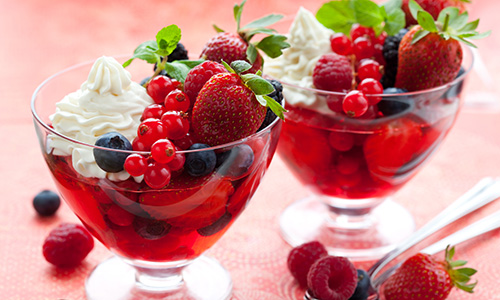
Ingredients for 4 servings:
- 1 sprig of basil
- 300 ml Champagne
- 100 g sugar
- 2 tbsp lemon juice
- 150 g strawberries
- 100 g red and black currants
- 100 g blackberries
- 100 g raspberries
- 6 sheets of gelatine or 1 sachet (9 g) of powdered gelatine (for 500 ml of liquid)
- 2 tbsp crème fraîche
- ½ sachet of vanilla sugar
In addition:
- Basil for garnish
Preparation:
- First soak the gelatine in cold water.
- Wash and shake the basil dry. Heat Champagne, sugar and lemon juice, then add basil and let steep.
- In the meantime, rinse and clean the berries. Remove currants from the panicle, slice strawberries into somewhat smaller pieces. Remove the basil from the liquid.
- Squeeze out gelatine and dissolve in the warm Champagne mixture, fold in berries and fill into 4 small moulds (approx. 200 ml liquid each) that have been rinsed with cold water. Refrigerate for approx. 2 hours and let gel.
- Unmould jellies. Mix vanilla sugar with the crème fraîche and then distribute on the jelly. Serve with a garnish of basil.
Click here for more information on cooking and baking with gelatine.
Nutrition facts:
- Calories: 242
- Joules: 1015
- Protein: 3.5 g
- Fat: 3.5 g
- Carbohydrates: 34.8 g
Berries – small, but oh my!
Strawberries, raspberries, blackberries and co. unfold their sweet flavour best when pampered by the summer sun. Their vibrant colours make many a dessert a sight to behold. However, berries, as these varieties of fruits are collectively called, are very delicate, and it is therefore recommended that consumers take a closer look before buying and only purchase containers of undamaged fruit. Furthermore, red currants should have a uniform colour, while fresh stems and sepals are a sign of good quality strawberries. To ensure that the berries remain fresh and delicious for a long time, care must also be taken when transporting or storing the berries to avoid pressure marks, which can lead to faster spoilage. Berries will then last up to two days when stored in the refrigerator. However, keep in mind that the more time that passes between harvest and consumption, the greater the loss of the valuable nutrients that protect somatic cells and keep the metabolism in shape.
Berries, especially darker varieties such as blackberries, contain a large number of phytochemicals. These are not only what gives the berries their vibrant colour, but, above all, gives rise to their anti-inflammatory effect. Moreover, these small fruits are veritably bursting with vitamin C. A serving of strawberries, for example, already meets the daily amount required for an adult of 100 g. This vitamin also works as an antioxidant in the organism. This means that free radicals are captured within the body, thus protecting the cells. Berries thereby play a role in supporting the immune system to prevent such conditions as cardiovascular diseases. They also keep the body radiant on the outside. With an average of 40 calories for every 100 g of berries, not only do they keep the waistline trim, but these stars of the summer are also chock full of fibre, which stimulates the digestion and produces a longer feeling of satiation – even when the berries are covered in jelly. So, start cooking and enjoy!